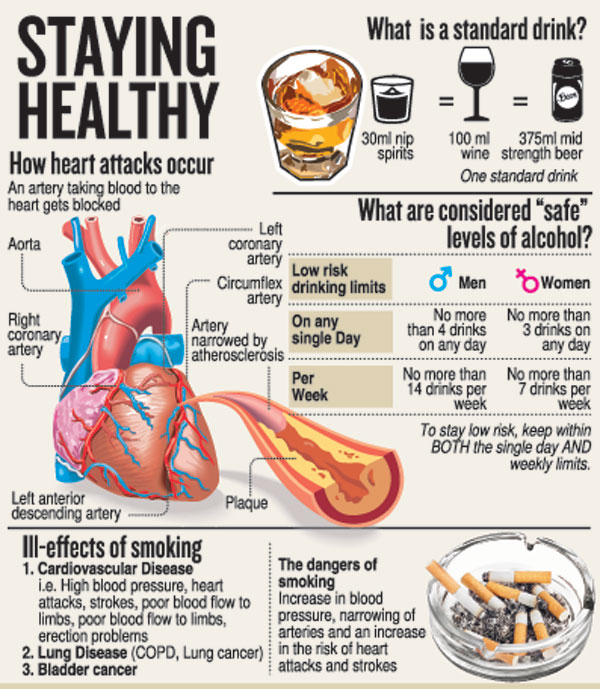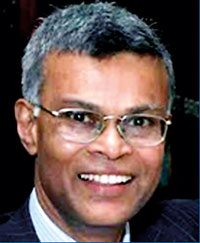Here’s to healthier and better living
View(s):Informal, interactive and easy-to-understand were the underlying chords throughout a Lecture on ‘Health for busy people – be more productive and achieve greater career success with a healthier lifestyle’ by well-known Dr. Sanjiva Wijesinha.
 At the lecture held on November 7 at the Galadari Hotel, Dr. Wijesinha points out that many busy executives have been focusing on career advancement without adequate attention to health, only to find themselves struck by health issues at the pinnacle of their career.
At the lecture held on November 7 at the Galadari Hotel, Dr. Wijesinha points out that many busy executives have been focusing on career advancement without adequate attention to health, only to find themselves struck by health issues at the pinnacle of their career.
Dr. Wijesinha, who was a Specialist Surgeon at the Lady Ridgeway Hospital for Children for many years is now an Associate Professor at the Faculty of Medicine, Monash University, Melbourne, Australia.
Clear and succinct, he shows the way to healthier and better living.
What is health? Is it being free of disease or disability? Is it being able to manage one’s ‘disease’ well, so it does not impact on one’s quality of life? Is it a state of well-being?
The definition of health by the World Health Organization (WHO) is: A state of complete physical, mental and social well-being – and not merely the absence of disease or infirmity.
The questions which then arise are: Are you too busy to look after your health? How can you be a good (efficient) professional and have good health? How can you balance all the different demands made on you?
When flying, do you listen to the in-flight safety instructions – you are advised, in case of an emergency, to don the oxygen mask ‘before’ putting it onto your child or helping others. This applies to you, even as a professional or an entrepreneur. But do you, as a busy professional or entrepreneur, look after your clients or business; subordinates, staff and customers; spouse and children, with ‘self’ coming in only last?
Lesson 1 – Before we care for others, we must first care for ourselves; Lesson 2 – Better health awareness among the people is more effective than better health facilities for the people.
Health awareness will mean knowing the various causes of common illness, knowing how to prevent illness and attending ‘early’ to warning signs of illness. To improve our health, we need to have ‘knowledge’ about health and the ‘will’ (desire or motivation) to change what needs to be changed.

Dr. Sanjiva Wijesinha
How do we run a successful business? By developing a ‘business plan’ and instituting new management techniques. So, how do we look after our health – by developing a ‘health plan’ and instituting new health management techniques for our health.
The major problems linked to health are heart disease, diabetes, cancer, stress, infection, injury, obesity (being overweight), lack of exercise, alcohol and smoking.
One of the commonest causes of ill-health in Sri Lanka is high blood pressure (hypertension), which leads to heart attacks, stroke and heart failure. Heart attacks occur when an artery taking blood to the heart gets blocked. Does a bypass operation cure heart disease? Once you have had a heart attack, the heart muscle supplied by the blocked artery is permanently damaged.
The risk factors for heart disease are:
Age
Sex (gender)
Family history (genes)
High blood pressure
High lipids (cholesterol)
Being overweight
Smoking
Stress
A sedentary lifestyle
Excess alcohol
Some risk factors are fixed (cannot be changed) some are variable (can be changed). While age (being older), gender (being male) and family history (genes) are fixed, all others are variable.
Another very common cause of ill-health is diabetes which leads to heart attacks and stroke, poor circulation to the legs, blindness and kidney failure. Diabetes is a serious and common disease in which the body becomes unable to use up sugar and damage occurs to the blood vessels and other organs.
Use ‘DIABETIC’ to manage diabetes:
D is for dietary discipline
I is for information
A is for attitude
B is for blood pressure/sugar
E is for exercise
T is for tablets
I is for insulin injections
C is for consultation
Prevention, especially in those at risk is important as well as early detection and effective management of diagnosed patients.
Take the case of a 40-year-old working as an accountant in Colombo and apply the SMASH technique (used in the Australian army) – Situation, Mission, Action, Supplies and Help.
Situation – 40-year-old accountant;
Mission – to be physically fit to enjoy life, to be mentally and spiritually healthy, to have a happy life, to prevent the development of chronic diseases, and improve the level of knowledge about health;
A – the actions that need to be taken;
S – the supplies that are needed;
H – who else can help you?
What is needed is a change in thinking. If you have a car and it suddenly develops a problem, don’t you take it at once to the garage to be checked? If you ensure that your car is taken for a service (check-up), why don’t you take yourself for an annual check-up?
You will never forget your birthday, so keep that month for your annual check-up as well to get your weight, height and girth as well as your blood pressure, blood glucose and blood cholesterol checked. A health check-up is good for you, good for your family, good for the community and good for the nation.
| The SNAP technique for health SNAP stands for ‘Smoking’, ‘Nutrition’, ‘Alcohol’ and ‘Physical Exercise’. Smoking – Smoking not only affects the lungs causing such diseases as lung cancer, chronic obstructive pulmonary disease (COPD or emphysema) and repeated chest infections but also cardiovascular disease which leads to high blood pressure, heart attacks, strokes, poor blood flow to the limbs and erection problems and bladder cancer. The dangers of smoking include an increase in blood pressure and narrowing of the arteries leading to an increase in the risk of heart attacks and strokes. Nutrition – The current WHO recommendation regarding sugar consumption is no more than 25 grams (six teaspoons) of sugar per person per day. When we eat sugar in our food that sugar has to be processed by our liver. If the liver is inundated by more sugar than it can handle, it gets damaged and the excess sugar is stored as fat. There is a lot of hidden sugar in not-so-obvious foods (tomato sauce, soft drinks or aerated waters and a cup of tea with tin-kiri) We get fat because of what we put into our mouths – remember that to burn up the 700 calories in a plate of 10 string hoppers (if one stringhopper weighs 30 gms and has 70 calories) will take one hour of running or 2½ hours of walking! Eat plenty of green vegetables with a minimum of refined carbohydrates (bread, pastries, patties, rolls and white rice). Alcohol – What is considered a safe level of alcohol? Low-risk drinking limits include on any single day – no more than 4 drinks for men and no more than 3 drinks for women. Per week – no more than 14 drinks per week for men and no more than 7 drinks for women. To stay low-risk, keep within both the single day and weekly limits. What is a (one) standard drink – 30ml nip spirits; or 100ml wine or 375ml mid-strength beer. Physical exercise – A sedentary job does make you tired, especially if it is mentally demanding and you work till late in the evening. At the end of an exhausting day, you want to do nothing more than go home, sit in front of the TV, have your dinner and then go to sleep. But if you can put in a half-hour or more of good physical exercise between workplace and home, you will get your circulation moving, it will help to keep your weight down and improve the oxygen flow to your brain (and so banish your fatigue). You will delay the inevitable onset of chronic ailments like high blood pressure, diabetes and arthritis. How much physical exercise? Thirty minutes of brisk walking every day – 150 minutes per week. It could be walking, swimming, cycling, gym (treadmill/machines), dancing and sports (netball/soccer) Incorporate exercise into your daily activity – get off the bus one or two stops earlier, join a walking group after work and exercise with a friend or spouse. How to make best use of your doctor? Find a good GP (General Practitioner, Family Physician, Family Doctor) with whom you have an ongoing relationship. See your GP once a year for a check-up. Your GP will help you decide whether you need to consult a Specialist. Before you go to see your GP, write down what your symptoms are.
| |
| The rules of three Many people these days work long hours and neglect their physical health. “I must start exercising, but I have no time,” is no excuse. It only means that exercise does not come high enough in your list of priorities. The Rules of Threes – Make sure that you use at least three hours every week, three days every month and three weeks every year to take time off your busy work schedule that you will inevitably have. Use the three hours to exercise, the three days to relax and spend time with your friends and the three weeks to go away from home on a vacation with your family. |


